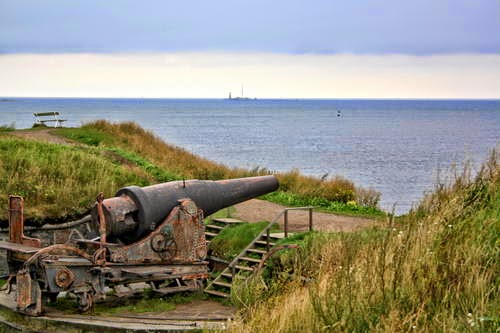Fortress of Suomenlinna
Built in the second half of the 18th century by Sweden on a group of islands located at the entrance of Helsinki's harbour, this fortress is an especially interesting example of European military architecture of the time.
Built in the second half of the 18th century by Sweden on a group of islands located at the entrance of Helsinki's harbour, this fortress is an especially interesting example of European military architecture of the time.
Long Description
In the history of military architecture, the Fortress of Finland (Suomenlinna) is an outstanding example representative both of the general fortification principles of the period and of its specific characteristics.
In 1747, when Finland was part of the Swedish realm, the Diet in Stockholm decided to build a fortress to serve as the main base for the armed forces stationed in Finland. A group of islands close to Helsinki were chosen to be the site of the fortress, which was to be called Sveaborg, the 'Fortress of Sweden', and construction began in 1748. The purpose was to link and fortify several islands so that entry into the city's harbour could be controlled.
The work began in 1748 under the supervision of the Swedish Admiral Augustin Ehrensvärd (1710-72), an artillery officer of aristocratic background in his mid-thirties. He adapted Vauban's theories to the very special geographical features of Helsinki. Ehrensvärd's original plan was to build a chain of linked fortifications across a group of islands close to Helsinki and to fortify certain strategic points on land around the town itself. The second part of the plan was never carried out, but by the time of his death in 1772 Ehrensvärd had produced the chain of forts, collectively called Sveaborg (Swedish Fortress), that were to protect the approaches to Helsinki. By the end of the century the construction work was virtually complete.
One of the main reasons for building Sveaborg was to help Sweden counter the ambitions of Russia, whose principal military base in the Gulf of Finland was Kronstadt, commissioned by Peter the Great to protect the city of St Petersburg and as the home port of a new Russian Navy to challenge Swedish maritime power in the eastern reaches of the Baltic Sea.
Although Sveaborg was operational at Ehrensvärd's death, fortification continued. King Gustav III (1771-92) seems to have taken a close interest in the work. The fortress was occupied by the Russians after the war of 1808-9 (despite its reputation as being invulnerable); it was again strengthened and its name was changed to Viapori. Swedish power in the region gradually declined and in 1808 Sveaborg was surrendered to Russian forces. In 1855, during the Crimean War, Franco-British soldiers bombarded the fortress to no avail. However, reconstruction work and new construction were undertaken. Following Finland's independence (1918), the name was changed a final time to Suomenlinna (Fortress of Finland). 6 km of walls and 190 buildings have been preserved.
Located on islands off Helsinki, Suomenlinna is a unique historical monument and one of the largest maritime fortresses in the world. Its history is closely entwined with that of Finland and the Baltic region. Helsinki can also thank Suomenlinna for its early growth and prosperity.
Source: UNESCO/CLT/WHC
Historical Description
In 1747 the Swedish Diet made a decision to fortify the eastern border and to establish a place d'armes on islands outside Helsinki. France, with which Sweden had a military alliance, financed a great part of the construction during the first decades.
Sveaborg was the largest construction project in Sweden in the 18th century. It was constructed under the supervision and direction of Lieutenant-Colonel Augustin Ehrensvard, assisted by the best Swedish engineering and mechanics experts. The fortress was constructed by soldiers in the regular army from all over Sweden and Finland. At its height, the construction crew totalled more than 6500. When Ehrensvard died in 1772, the fortress was virtually ready for use. The overall plan was revisecf in 1774.
European power politics also determined Sveaborg's fate. In the war of 1808-1809, which was a direct consequence of the treaties between Napoleon and Alexander I, Russia occupied Finland. Sveaborg surrendered and became a Russian garrison for the following 110 years. At the turn of the century there were about 4000 Russian soldiers in Sveaborg. The fortress remained in the state it had been under Swedish rule until the bombings during the Crimean War in 1855, when the British and French Navies ·fired on the fort. In the repairs and modernisation , undertaken after .that, some of the damaged buildings were torn down or made lower and a new coastal defence line of earth banks was constructed.
Before the First World War, Sveaborg, mainly serving as a depot area, formed part of the defence scheme, "Peter the Great's Sea Fortress". The intention was that Sveaborg, together with Tallinn, would block off the entire Gulf of Finland and guarantee the security of St Petersburg, the Capital of Russia. After Finland became independent in 1917, Sveaborg became a Finnish garrison and was renamed in Finnish as Suomenlinna. It served as a prison camp after the Civil War in 1918-1919. Suomenlinna was in military use for the last time during the Second World War when it served as one of Helsinki's air surveillance centres. It served as a garrison until 1972. Its use for tourism and recreation began on a larger scale after 1963 .
Source: UNESCO/CLT/WHC
Share Thread Share your opinion interested




EmoticonEmoticon